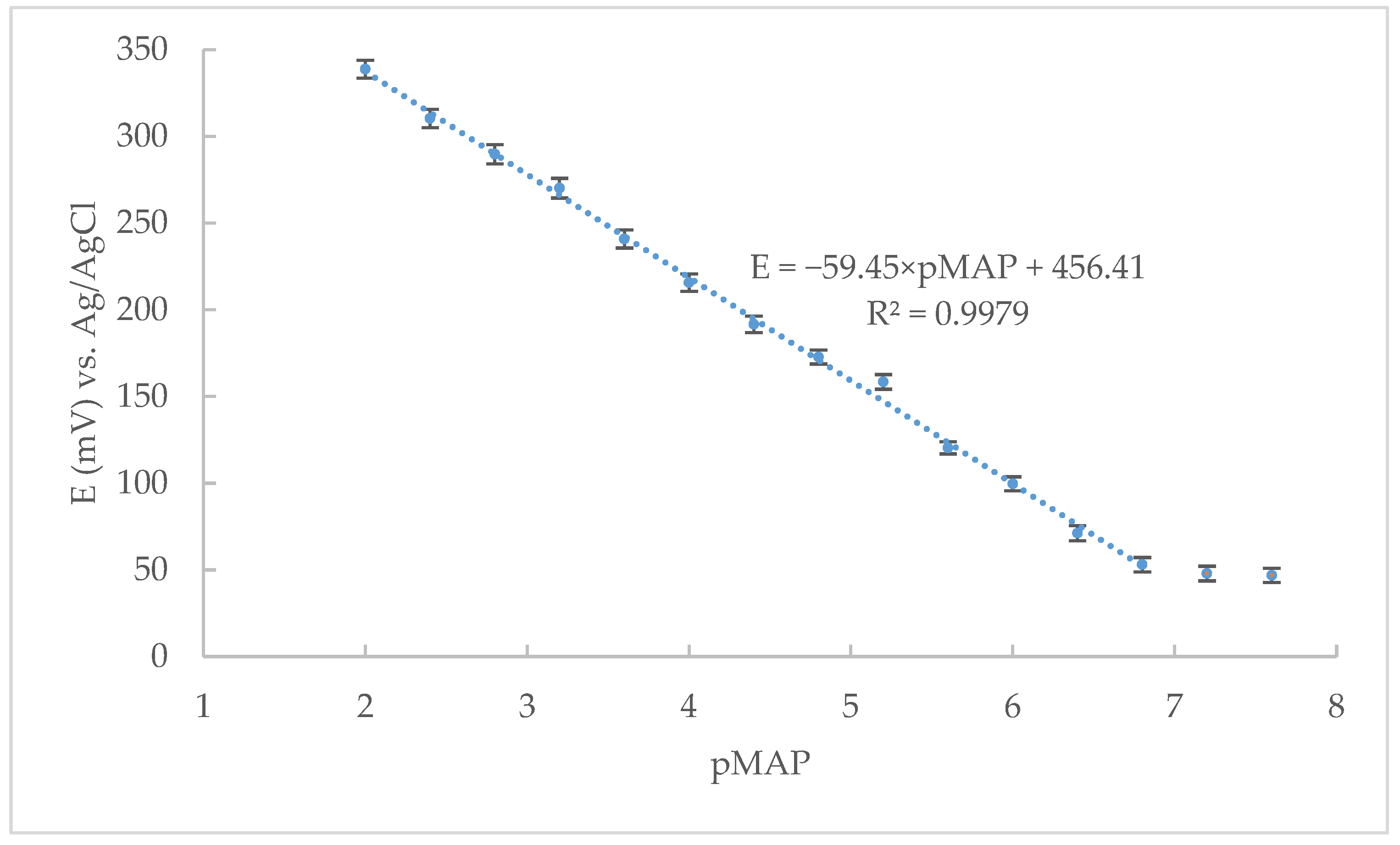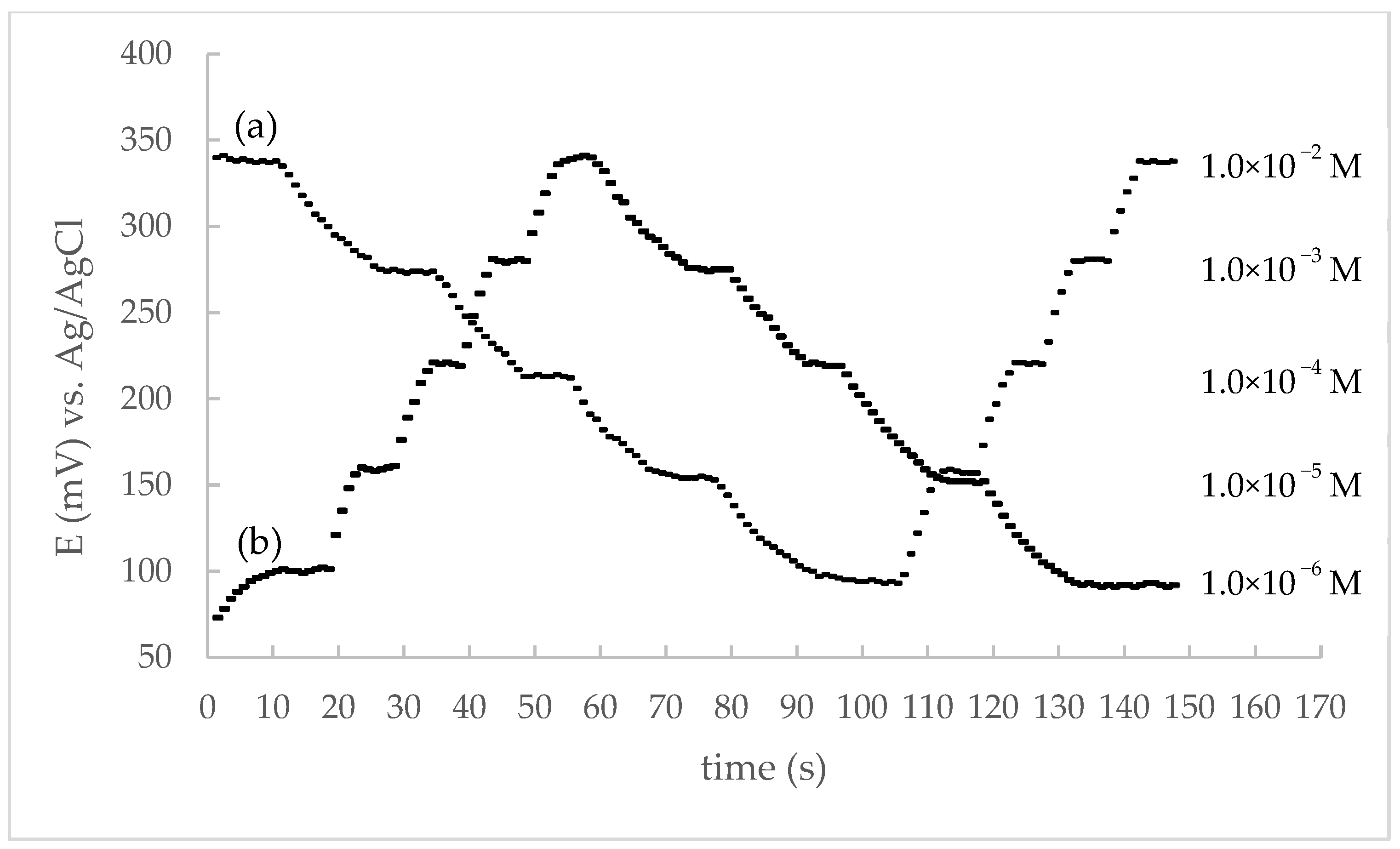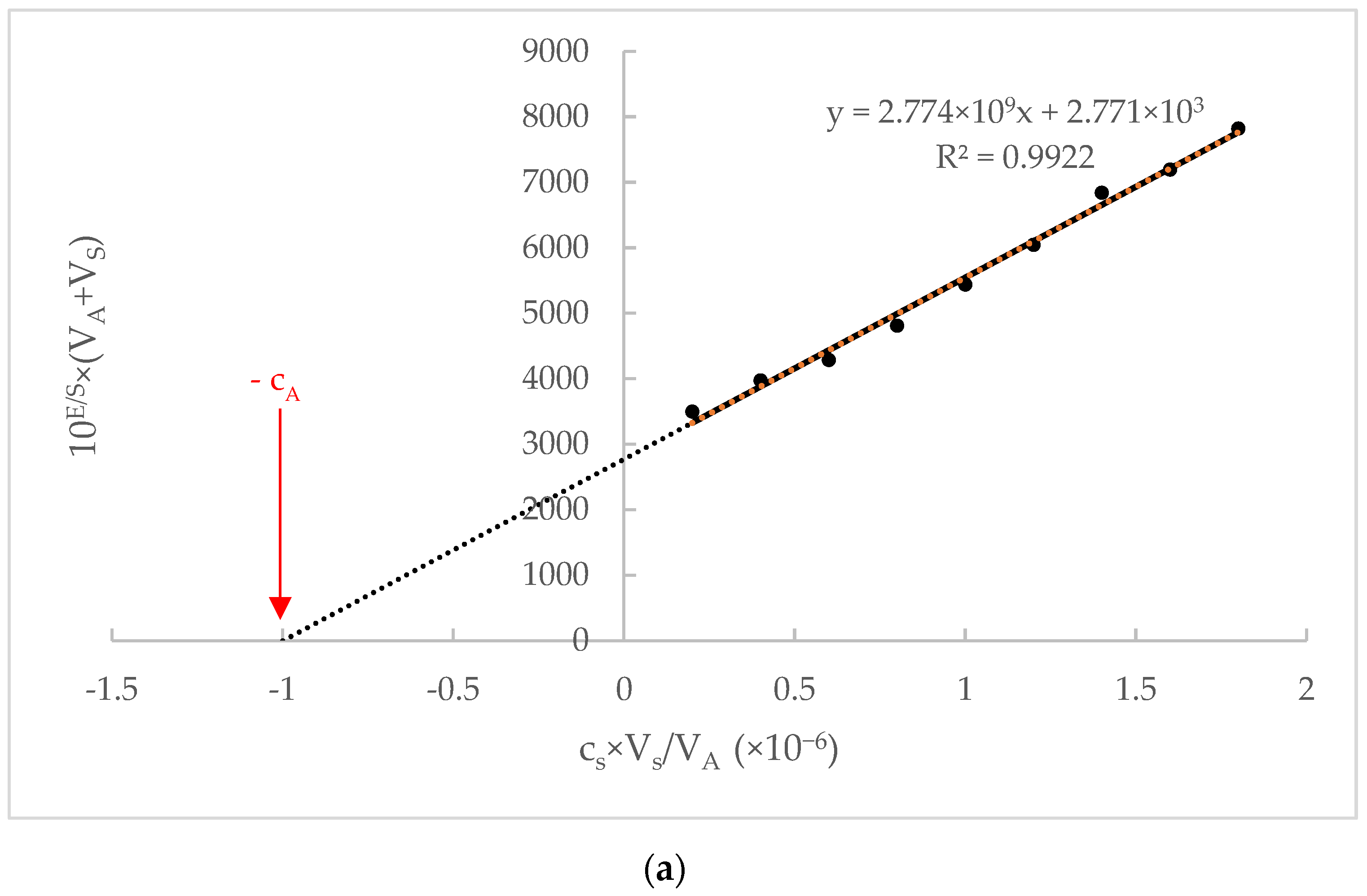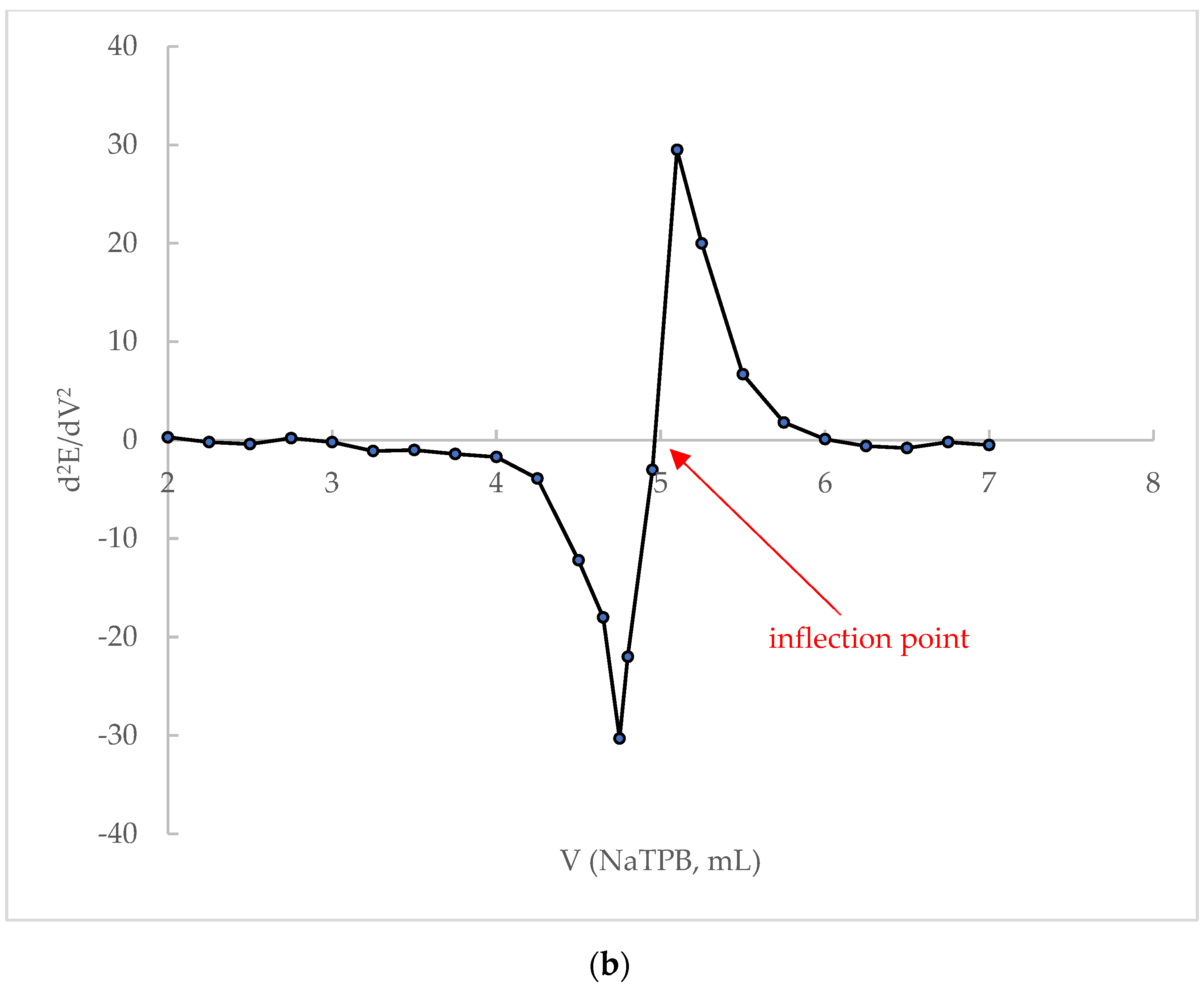Potentiometric Determination of Maprotiline Hydrochloride in Pharmaceutical and Biological Matrices Using a Novel Modified Carbon Paste Electrode
Abstract
:1. Introduction
2. Materials and Methods
2.1. Chemicals and Reagents
2.2. Apparatus and Measurements
2.3. Preparation of the Ion-Association Complexes
2.4. Preparation of CPE
2.5. Procedures
2.6. Determination of Selectivity
2.7. Determination of Maprotiline in Tablet and Human Urine Samples
3. Results and Discussion
3.1. Optimization of the CPE Composition
3.1.1. Selection and Optimization of Liquid Binder
3.1.2. Study of IAC—Various Amount and Type
3.1.3. Role and Selection of Lipophilic Additive
3.2. Potentiometric Characteristics of Optimized CPE
3.2.1. pH Study
3.2.2. Dynamic Response Time, Reversibility, and Reproducibility of CPE
3.2.3. Interference Study
3.3. Analytical Applications
4. Conclusions
Author Contributions
Funding
Institutional Review Board Statement
Informed Consent Statement
Conflicts of Interest
References
- Richardson, L.; Brahmbhatt, A. Depression in Primary Care. J. Nurse Pract. 2021, 17, 37–43. [Google Scholar] [CrossRef]
- Salinero-Fort, M.A.; Gómez-Campelo, P.; Cárdenas-Valladolid, J.; San Andrés-Rebollo, F.J.; de Miguel-Yanes, J.M.; de Burgos-Lunar, C. Effect of depression on mortality in type 2 diabetes mellitus after 8 years of follow-up. The DIADEMA study. Diabetes Res. Clin. Pract. 2021, 176, 108863. [Google Scholar] [CrossRef] [PubMed]
- Cavus, I.; Kanberoglu, G.S. Development of a potentiometric maprotiline-selective electrode and its application in pharmaceutıcal samples. Microchem. J. 2019, 148, 57–65. [Google Scholar] [CrossRef]
- Goodwin, G.M. Depression and associated physical diseases and symptoms. Dialogues Clin. Neurosci. 2006, 8, 259–265. [Google Scholar] [CrossRef] [PubMed]
- Reppermund, S.; Heintze, T.; Srasuebkul, P.; Trollor, J.N. Health Profiles, Health Services Use, and Transition to Dementia in Inpatients with Late-Life Depression and Other Mental Illnesses. J. Am. Med. Dir. Assoc. 2021, 22, 1465–1470. [Google Scholar] [CrossRef] [PubMed]
- Caneo, C.; Marston, L.; Bellón, J.Á.; King, M. Examining the relationship between physical illness and depression: Is there a difference between inflammatory and non inflammatory diseases? A cohort study. Gen. Hosp. Psychiatry 2016, 43, 71–77. [Google Scholar] [CrossRef] [PubMed] [Green Version]
- Koenig, H.G.; Berk, L.S.; Daher, N.S.; Pearce, M.J.; Bellinger, D.L.; Robins, C.J.; Nelson, B.; Shaw, S.F.; Cohen, H.J.; King, M.B. Religious involvement is associated with greater purpose, optimism, generosity and gratitude in persons with major depression and chronic medical illness. J. Psychosom. Res. 2014, 77, 135–143. [Google Scholar] [CrossRef] [PubMed]
- Gouvernet, B.; Bonierbale, M. Bio-psychosocial study on the impact of the COVID-19 lockdown on depression and anxiety in a sample of 1753 French-speaking subjects. L’encephale 2022, 48, 118–124. [Google Scholar] [CrossRef]
- Xu, F.; Wang, X.; Yang, Y.; Zhang, K.; Shi, Y.; Xia, L.; Hu, X.; Liu, H. Depression and insomnia in COVID-19 survivors: A cross-sectional survey from Chinese rehabilitation centers in Anhui province. Sleep Med. 2022, 91, 161–165. [Google Scholar] [CrossRef] [PubMed]
- Gul, Z.B. Depression and sexual functions in epilepsy patients: Comparison before and during the COVID-19 pandemic. Ann. Med. Psychol. 2022, 180, 127–132. [Google Scholar] [CrossRef]
- Liu, C.; Pan, W.; Li, L.; Li, B.; Ren, Y.; Ma, X. Prevalence of depression, anxiety, and insomnia symptoms among patients with COVID-19: A meta-analysis of quality effects model. J. Psychosom. Res. 2021, 147, 110516. [Google Scholar] [CrossRef] [PubMed]
- Estrela, M.; Silva, T.M.; Gomes, E.R.; Piñeiro, M.; Figueiras, A.; Roque, F.; Herdeiro, M.T. Prescription of anxiolytics, sedatives, hypnotics and antidepressants in outpatient, universal care during the COVID-19 pandemic in Portugal: A nationwide, interrupted time-series approach. J. Epidemiol. Community Health 2022, 76, 335–340. [Google Scholar] [CrossRef] [PubMed]
- Lear-Claveras, A.; González-Álvarez, B.; Couso-Viana, S.; Clavería, A.; Oliván-Blázquez, B. Analysis of Clinical Parameters, Drug Consumption and Use of Health Resources in a Southern European Population with Alcohol Abuse Disorder during COVID-19 Pandemic. Int. J. Environ. Res. Public Health 2022, 19, 1358. [Google Scholar] [CrossRef]
- Diaz-Camal, N.; Cardoso-Vera, J.D.; Islas-Flores, H.; Gómez-Oliván, L.M.; Mejía-García, A. Consumption and ocurrence of antidepressants (SSRIs) in pre- and post-COVID-19 pandemic, their environmental impact and innovative removal methods: A review. Sci. Total Environ. 2022, 829, 154656. [Google Scholar] [CrossRef] [PubMed]
- Gonçalves, N.P.F.; Varga, Z.; Bouchonnet, S.; Dulio, V.; Alygizakis, N.; Dal Bello, F.; Medana, C.; Calza, P. Study of the photoinduced transformations of maprotiline in river water using liquid chromatography high-resolution mass spectrometry. Sci. Total Environ. 2021, 755, 143556. [Google Scholar] [CrossRef]
- Coccaro, E.F.; Siever, L.J. Second Generation Antidepressants: A Comparative Review. J. Clin. Pharmacol. 1985, 25, 241–260. [Google Scholar] [CrossRef]
- Breyer-Pfaff, U.; Kroeker, M.; Winkler, T.; Kriemler, P. Isolation and identification of hydroxylated maprotiline metabolites. Xenobiotica 1985, 15, 57–66. [Google Scholar] [CrossRef] [PubMed]
- Đurić, S.L.; Nasković, D.; Veličković, D.T.; Milenović, D.M. Development and validation of stability indicating chromatographic method for determination of impurities in maprotiline pharmaceutical tablets. J. Anal. Chem. 2015, 70, 225–233. [Google Scholar] [CrossRef]
- Wong, S.H.Y.; Waugh, S.W. Determination of the antidepressants maprotiline and amoxapine, and their metabolites, in plasma by liquid chromatography. Clin. Chem. 1983, 29, 314–318. [Google Scholar] [CrossRef]
- Pankajkumar-Patel, N.; Peris-García, E.; Ruiz-Angel, M.J.; García-Alvarez-Coque, M.C. Analysis of tricyclic antidepressants in pharmaceuticals by microemulsion liquid chromatography. Microchem. J. 2021, 160, 105659. [Google Scholar] [CrossRef]
- Onal, C.; Kepekçi Tekkeli, S.E. Stability-indicating ultra-fast liquid chromatographic analysis of maprotiline in pharmaceutical formulations. J. Chem. Metrol. 2019, 13, 80–83. [Google Scholar] [CrossRef]
- Zheng, M.; Zhang, C.; Wang, L.; Wang, K.; Kang, W.; Lian, K.; Li, H. Determination of nine mental drugs in human plasma using solid-phase supported liquid-liquid extraction and HPLC-MS/MS. Microchem. J. 2021, 160, 105647. [Google Scholar] [CrossRef]
- Ma, W.; Gao, X.; Guo, H.; Chen, W. Determination of 13 antidepressants in blood by UPLC-MS/MS with supported liquid extraction pretreatment. J. Chromatogr. B 2021, 1171, 122608. [Google Scholar] [CrossRef] [PubMed]
- Tekce, S.; Subasi, Y.; Coldur, F.; Kanberoglu, G.S.; Zahmakiran, M. Development of a PVC Membrane Potentiometric Sensor with Low Detection Limit and Wide Linear Range for the Determination of Maprotiline in Pharmaceutical Formulations. ChemistrySelect 2022, 7, e202103553. [Google Scholar] [CrossRef]
- Wang, J. Analytical Electrochemistry; John Wiley & Sons, Inc.: Hoboken, NJ, USA, 2006; ISBN 9780471790303. [Google Scholar]
- Harvey, D. Modern Analytic Chemistry; McGraw-Hill: London, UK, 2000; ISBN 0–07–237547–7. [Google Scholar]
- Bard, A.J.; Zoski, C.G. Electroanalytical Chemistry; Bard, A.J., Zoski, C.G., Eds.; CRC Press: Boca Raton, FL, USA, 2010; ISBN 9780429139802. [Google Scholar]
- Skoog, D.A.; West, D.M.; Holler, J.F. Osnove Analitičke Kemije; Školska knjiga: Zagreb, Croatia, 1999. [Google Scholar]
- Piljac, I. Senzori Fizikalnih Veličina i Elektroanalitičke Metode; Media Print Tiskara Hrastić: Zagreb, Croatia, 2010; ISBN 9789535848707. [Google Scholar]
- Parvataneni, S.V.; Nagarjuna, P.J. Development and validation for the simultaneous determination of trifluoperazine hydrochloride and trihexyphenidyl hydrochloride in a solid oral dosage form by RP-HPLC. World J. Pharm. Pharm. Sci. 2014, 3, 1021–1031. [Google Scholar]
- Gupta, V.K.; Nayak, A.; Agarwal, S.; Singhal, B. Recent Advances on Potentiometric Membrane Sensors for Pharmaceutical Analysis. Comb. Chem. High Throughput Screen. 2011, 14, 284–302. [Google Scholar] [CrossRef]
- Ammar, R.A. A new atomoxetine hydrochloride selective electrode and its pharmaceuticals application. Int. J. Pharm. Sci. Rev. Res. 2016, 36, 242–246. [Google Scholar]
- El-Tohamy, M.; Razeq, S.; El-Maamly, M.; Shalaby, A. Polymeric membrane sensors for direct determination of tricyclic antidepressant Clomipramine hydrochloride in pharmaceutical formulations and biological fluids. Med. Chem. Anal. 2014, 4, 130–140. [Google Scholar]
- Issa, Y.M.; Khorshid, A.F. Using PVC ion-selective electrodes for the potentiometric flow injection analysis of distigmine in its pharmaceutical formulation and biological fluids. J. Adv. Res. 2011, 2, 25–34. [Google Scholar] [CrossRef] [Green Version]
- El-Kosasy, A.M.; Abdel Rahman, M.H.; Abdelaal, S.H. Graphene nanoplatelets in potentiometry: A nanocomposite carbon paste and PVC based membrane sensors for analysis of Vilazodone HCl in plasma and milk samples. Talanta 2019, 193, 9–14. [Google Scholar] [CrossRef] [PubMed]
- Abdel-Haleem, F.M.; Mahmoud, S.; Abdel-Ghani, N.E.T.; El Nashar, R.M.; Bechelany, M.; Barhoum, A. Polyvinyl Chloride Modified Carbon Paste Electrodes for Sensitive Determination of Levofloxacin Drug in Serum, Urine, and Pharmaceutical Formulations. Sensors 2021, 21, 3150. [Google Scholar] [CrossRef]
- Al-Harbi, E.A.; Abdelrahman, M.H.; El-Kosasy, A.M. Ecofriendly Long Life Nanocomposite Sensors for Determination of Carbachol in Presence of Choline: Application in Ophthalmic Solutions and Biological Fluids. Sensors 2019, 19, 2357. [Google Scholar] [CrossRef] [PubMed] [Green Version]
- Radić, J.; Buljac, M.; Genorio, B.; Gričar, E.; Kolar, M. A Novel Reduced Graphene Oxide Modified Carbon Paste Electrode for Potentiometric Determination of Trihexyphenidyl Hydrochloride in Pharmaceutical and Biological Matrices. Sensors 2021, 21, 2955. [Google Scholar] [CrossRef] [PubMed]
- Alarfaj, N.A.; El-Tohamy, M.F. Construction and Validation of New Electrochemical Carbon Nanotubes Sensors for Determination of Acebutolol Hydrochloride in Pharmaceuticals and Biological Fluids. J. Chin. Chem. Soc. 2014, 61, 910–920. [Google Scholar] [CrossRef]
- Issa, Y.M.; Abou Attia, F.M.; Sherif, O.E.; Abo Dena, A.S. Potentiometric and surface topography studies of new carbon-paste sensors for determination of thiamine in Egyptian multivitamin ampoules. Arab. J. Chem. 2017, 10, 751–760. [Google Scholar] [CrossRef]
- Rassi, S.F. Chemically modified carbon paste ion-selective electrodes for determination of atorvastatin calcium in pharmaceutical preparations. Anal. Chem. Res. 2017, 12, 65–73. [Google Scholar] [CrossRef]
- Abu Shawish, H.M.; Abed Almonem, K.I.; Saadeh, S.M.; Al-lham, W.S. Determination of haloperidol drug in ampoules and in urine samples using a potentiometric modified carbon paste electrode. Measurement 2016, 78, 180–186. [Google Scholar] [CrossRef]
- Dehnavi, A.; Soleymanpour, A. New chemically modified carbon paste sensor for nanomolar concentration measurement of rifampicin in biological and pharmaceutical media. Mater. Sci. Eng. C 2019, 94, 403–409. [Google Scholar] [CrossRef]
- Frag, E.Y.; El badry Mohamed, M.; Mohamed, G.G.; Ebrahim, M.S. Selective potentiometric sensors for the determination of butenafine hydrochloride in a cream formulation. Microchem. J. 2020, 157, 104870. [Google Scholar] [CrossRef]
- Rouhani, M.; Soleymanpour, A. A new selective carbon paste electrode for potentiometric analysis of olanzapine. Measurement 2019, 140, 472–478. [Google Scholar] [CrossRef]
- Afkhami, A.; Shirzadmehr, A.; Madrakian, T.; Bagheri, H. New nano-composite potentiometric sensor composed of graphene nanosheets/thionine/molecular wire for nanomolar detection of silver ion in various real samples. Talanta 2015, 131, 548–555. [Google Scholar] [CrossRef]
- Abu Shawish, H.M.; Elhabiby, M.; Abu Aziz, H.S.; Saadeh, S.M.; Tbaza, A. Determination of Trihexyphenidyl hydrochloride drug in tablets and urine using a potentiometric carbon paste electrode. Sens. Actuators B Chem. 2016, 235, 18–26. [Google Scholar] [CrossRef]
- Švancara, I.; Kalcher, K.; Walcarius, A.; Vytras, K. Electroanalysis with Carbon Paste Electrodes; CRC Press: Boca Raton, FL, USA, 2012; ISBN 9780429152078. [Google Scholar]
- Elashery, S.E.A.; Frag, E.Y.; Sleim, A.A.E. Novel and selective potentiometric sensors for Cinchocaine HCl determination in its pure and Co-formulated dosage form: A comparative study of in situ carbon sensors based on different ion pairing agents. Measurement 2021, 173, 108549. [Google Scholar] [CrossRef]
- Reinhoudt, D.N.; Engbersen, J.F.J.; Brzozka, Z.; van der Vlekkert, H.H.; Honig, G.W.N.; Holterman, H.A.J.; Verkerk, U.H. Development of Durable K+-Selective Chemically Modified Field Effect Transistors with Functionalized Polysiloxane Membranes. Anal. Chem. 1994, 66, 3618–3623. [Google Scholar] [CrossRef] [Green Version]
- Li, M.; Zhang, H.; Chen, B.; Wu, Y.; Guan, L. Prediction of pKa Values for Neutral and Basic Drugs based on Hybrid Artificial Intelligence Methods. Sci. Rep. 2018, 8, 3991. [Google Scholar] [CrossRef] [Green Version]
- Švancara, I.; Walcarius, A.; Kalcher, K.; Vytřas, K. Carbon paste electrodes in the new millennium. Open Chem. 2009, 7, 598–656. [Google Scholar] [CrossRef]
- Aglan, R.F.; Hamed, M.M.; Saleh, H.M. Selective and sensitive determination of Cd(II) ions in various samples using a novel modified carbon paste electrode. J. Anal. Sci. Technol. 2019, 10, 7. [Google Scholar] [CrossRef] [Green Version]
- Khorshid, A.F. New analysis of clopidogrel bisulfate in plavix tablet and human biological fluids utilizing chemically modified carbon paste sensor. Arab. J. Chem. 2019, 12, 1740–1750. [Google Scholar] [CrossRef]






| Ion-Association Complex | C (%) | H (%) | N (%) | |
|---|---|---|---|---|
| MAP-TPB | Calculated | 88.4 | 7.4 | 2.3 |
| Found | 87.7 | 7.3 | 2.5 | |
| MAP3-PT | Calculated | 19.4 | 2.0 | 1.1 |
| Found | 19.8 | 2.2 | 1.0 | |
| MAP3-PM | Calculated | 27.1 | 2.7 | 1.6 |
| Found | 27.0 | 2.9 | 1.7 | |
| MAP-R | Calculated | 48.3 | 5.1 | 16.4 |
| Found | 48.5 | 5.0 | 16.4 |
| mCPE (no.) | Ingredient (%) *** | Linear Range (mol L−1) | Detection Limit **** (mol L−1) | Slope (mV/dec)± SD ** | R2 | |||||
|---|---|---|---|---|---|---|---|---|---|---|
| Binder | IAC | Salt | ||||||||
| Efect of the type of binder | ||||||||||
| 1 | 49.1 (DPB) | 2.0 | MAP-TPB | 0.1 (NaTPB) | 2.5 × 10−6–1.0 × 10−2 | 2.3 × 10−6 | −50.3 ± 2.3 | 0.9907 | ||
| 2 | 49.0 (DOP) | 2.1 | 2.5 × 10−6–1.0 × 10−2 | 2.2 × 10−6 | −51.4 ± 1.9 | 0.9910 | ||||
| 3 | 48.8 (DEHA) | 2.0 | 1.6 × 10−5–1.0 × 10−2 | 1.6 × 10−5 | −27.4 ± 3.9 | 0.9614 | ||||
| 4 | 49.0 (PO) | 1.9 | - | - | −6.0 ± 3.9 | 0.6115 | ||||
| 5 | 49.1 (TEPh) | 2.0 | 6.3 × 10−6–4.0 × 10−3 | 5.8 × 10−6 | −79.3 ± 3.8 | 0.9873 | ||||
| 6 * | 49.0 (NPOE) | 2.0 | 1.6 × 10−7–1.0 × 10−2 | 1.1 × 10−7 | −59.5 ± 0.8 | 0.9979 | ||||
| Effect of differnet type and proportion of IACs | ||||||||||
| 7 | 48.8 | NPOE | 0.7 | MAP-TPB | 0.1 (NaTPB) | 1.0 × 10−6–1.0 × 10−2 | 9.7 × 10−7 | −55.4 ± 1.1 | 0.9928 | |
| 6 * | 49.0 | 2.0 | 1.6 × 10−7–1.0 × 10−2 | 1.1 × 10−7 | −59.5 ± 0.8 | 0.9979 | ||||
| 8 | 48.8 | 5.3 | 2.5 × 10−6–1.6 × 10−3 | 1.9 × 10−6 | −82.1 ± 2.8 | 0.9905 | ||||
| 9 | 49.2 | 0.8 | MAP3-PT | 2.5 × 10−6–1.0 × 10−2 | 2.4 × 10−6 | −52.3 ± 1.4 | 0.9913 | |||
| 10 | 48.9 | 2.1 | 1.0 × 10−6–4.0 × 10−3 | 9.2 × 10−7 | −52.9 ± 1.4 | 0.9921 | ||||
| 11 | 49.2 | 5.4 | 2.5 × 10−6–4.0 × 10−3 | 2.0 × 10−6 | −52.1 ± 1.9 | 0.9948 | ||||
| 12 | 49.0 | 0.8 | MAP3-PM | 6.3 × 10−6–4.0 × 10−3 | 6.0 × 10−6 | −51.3 ± 2.4 | 0.9849 | |||
| 13 | 48.9 | 2.0 | 2.5 × 10−6–1.6 × 10−3 | 1.9 × 10−6 | −51.9 ± 2.0 | 0.9900 | ||||
| 14 | 49.1 | 5.2 | 1.6 × 10−5–4.0 × 10−3 | 1.6 × 10−5 | −50.1 ± 0.9 | 0.9952 | ||||
| 15 | 48.9 | 0.7 | MAP-R | - | - | −13.8 ± 4.4 | 0.7808 | |||
| 16 | 49.2 | 2.2 | - | - | −13.9 ± 6.9 | 0.6259 | ||||
| 17 | 49.1 | 5.2 | - | - | −12.8 ± 3.4 | 0.8041 | ||||
| Effect of differnet type and proportion of ionic additive | ||||||||||
| 6 * | 49.0 | NPOE | 2.0 | MAP-TPB | 0.1 | NaTPB | 1.6 × 10−7–1.0 × 10−2 | 1.1 × 10−7 | −59.5 ± 0.8 | 0.9979 |
| 18 | 49.0 | 2.0 | 0.3 | 2.5 × 10−6–4.0 × 10−3 | 2.3 × 10−6 | −88.7 ± 3.2 | 0.9937 | |||
| 19 | 49.2 | 2.1 | 0.6 | 6.3 × 10−6–4.0 × 10−3 | 6.1 × 10−6 | −89.1 ± 3.7 | 0.9871 | |||
| 20 | 48.8 | 2.1 | 0.1 | TBATPB | 2.5 × 10−6–1.0 × 10−3 | 2.2 × 10−6 | −48.2 ± 1.6 | 0.9931 | ||
| 21 | 49.1 | 1.9 | 0.3 | 2.5 × 10−6–4.0 × 10−3 | 2.2 × 10−6 | −48.0 ± 1.4 | 0.9919 | |||
| 22 | 49.1 | 2.0 | 0.7 | 6.3 × 10−6–1.0 × 10−2 | 5.7 × 10−6 | −44.5 ± 1.7 | 0.9799 | |||
| Foreign Ions | |
|---|---|
| K+ | 4.1 |
| Na+ | 3.9 |
| Li+ | 3.7 |
| NH4+ | 4.2 |
| Cu2+ | 3.6 |
| Ca2+ | 3.8 |
| Mg2+ | 3.8 |
| Co2+ | 3.3 |
| Zn2+ | 3.4 |
| Al3+ | 3.5 |
| Fe3+ | 3.0 |
| L-arginine | 4.2 |
| L-cysteine | 4.0 |
| Lactose | 3.7 |
| Glucose | 3.4 |
| Galactose | 3.6 |
| Fructose | 3.9 |
| acetylsalicylic acid | 3.8 |
| Paracetamol | 4.3 |
| trihexyphenydil hydrochloride | 2.9 |
| Expected Data (mol L−1) | Recovery ± RSD * (%) | ||
|---|---|---|---|
| Pure solutions | Standard addition method | 1.0 × 10−4 | 99.3 ± 0.5 |
| 1.0 × 10−5 | 99.2 ± 0.6 | ||
| 1.0 × 10−6 | 98.3 ± 2.1 | ||
| Potentiometric titration | 1.0 × 10−4 | 99.0 ± 0.8 | |
| 1.0 × 10−5 | 99.0 ± 0.6 | ||
| 1.0 × 10−6 | 95.2 ± 5.0 | ||
| Ludiomil tablets | Standard addition method | 1.0 × 10−4 | 100.5 ± 0.6 |
| 1.0 × 10−5 | 100.7 ± 0.9 | ||
| 1.0 × 10−6 | 98.1 ± 2.7 | ||
| Potentiometric titration | 1.0 × 10−4 | 98.9 ± 0.8 | |
| 1.0 × 10−5 | 98.2 ± 1.4 | ||
| 1.0 × 10−6 | 94.3 ± 5.4 | ||
| Spiked urine samples | Standard addition method | 1.0 × 10−4 | 98.3 ± 1.2 |
| 1.0 × 10−5 | 97.9 ± 1.0 | ||
| 1.0 × 10−6 | 103.1 ± 2.8 | ||
| Potentiometric titration | 1.0 × 10−4 | 97.6 ± 1.4 | |
| 1.0 × 10−5 | 97.2 ± 1.6 | ||
| 1.0 × 10−6 | 93.0 ± 4.2 |
| Parameter | Proposed CPE | PVC-Based Sensor [3] | PVC-Based Sensor with Ionophore [24] |
|---|---|---|---|
| slope (mV dec−1) | 59.5 ± 0.8 | 55.4 | 59.1 ± 0.4 |
| correlation coefficient | 0.9979 | 0.9999 | 0.9934 |
| limit of detection (mol L−1) | 1.1 × 10−7 | 5.0 × 10−6 | 9.0 × 10−10 |
| linear dynamic range (mol L−1) | 1.6 × 10−7–1.0 × 10−2 | 1.0 × 10−5–1.0 × 10−2 | 1.0 × 10−9–1.0 × 10−2 |
| response time (s) | <5 | 5 | <5 |
| working pH range | 2.4–9.6 | 3.0–5.0 | 2.0–9.5 |
| operating pH value | 4.5 (acetate buffer) | 3.5 (phosphate buffer) | 3.1 (phosphate buffer) |
| average recovery in aliquot of Ludiomil tablets | 100.7 ± 0.9 * | 99.6 ± 4.4 *** | 98.0 ± 2.0 **** |
| 98.1 ± 2.7 ** |
Publisher’s Note: MDPI stays neutral with regard to jurisdictional claims in published maps and institutional affiliations. |
© 2022 by the authors. Licensee MDPI, Basel, Switzerland. This article is an open access article distributed under the terms and conditions of the Creative Commons Attribution (CC BY) license (https://creativecommons.org/licenses/by/4.0/).
Share and Cite
Radić, J.; Perović, D.; Gričar, E.; Kolar, M. Potentiometric Determination of Maprotiline Hydrochloride in Pharmaceutical and Biological Matrices Using a Novel Modified Carbon Paste Electrode. Sensors 2022, 22, 9201. https://doi.org/10.3390/s22239201
Radić J, Perović D, Gričar E, Kolar M. Potentiometric Determination of Maprotiline Hydrochloride in Pharmaceutical and Biological Matrices Using a Novel Modified Carbon Paste Electrode. Sensors. 2022; 22(23):9201. https://doi.org/10.3390/s22239201
Chicago/Turabian StyleRadić, Josip, Dorotea Perović, Ema Gričar, and Mitja Kolar. 2022. "Potentiometric Determination of Maprotiline Hydrochloride in Pharmaceutical and Biological Matrices Using a Novel Modified Carbon Paste Electrode" Sensors 22, no. 23: 9201. https://doi.org/10.3390/s22239201
APA StyleRadić, J., Perović, D., Gričar, E., & Kolar, M. (2022). Potentiometric Determination of Maprotiline Hydrochloride in Pharmaceutical and Biological Matrices Using a Novel Modified Carbon Paste Electrode. Sensors, 22(23), 9201. https://doi.org/10.3390/s22239201








